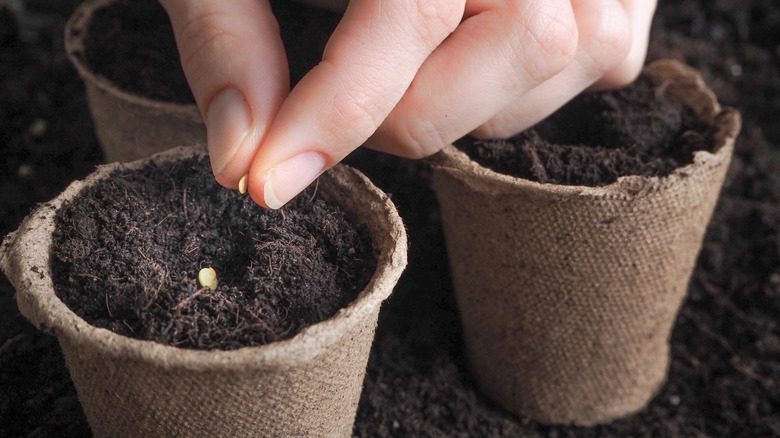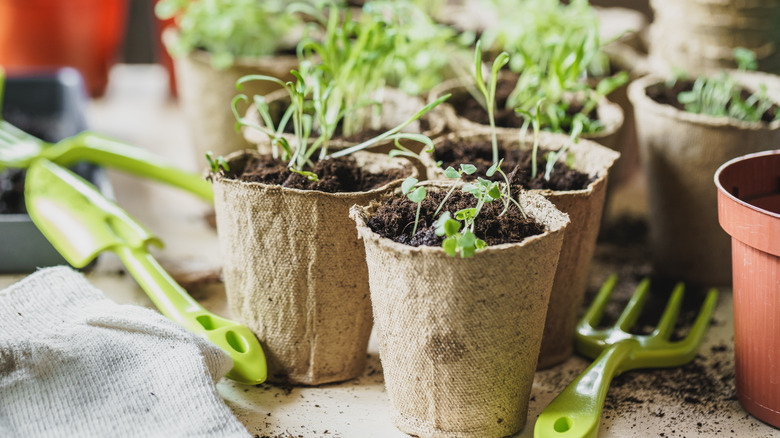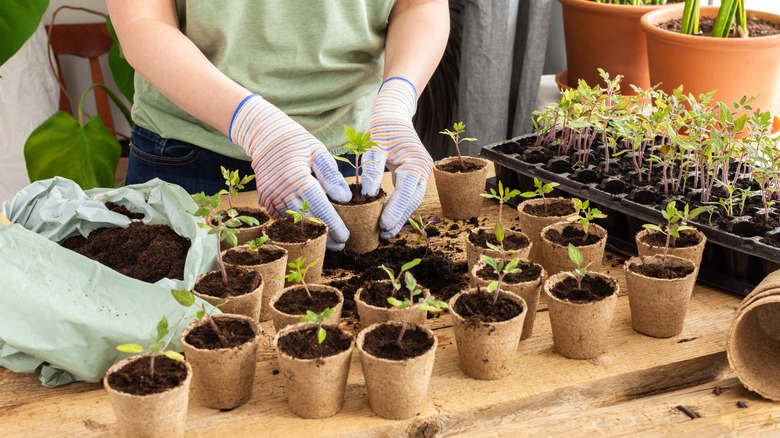Why Martha Stewart Recommends Starting Tomato Seeds In Peat Pots
Martha Stewart has several tips for growing healthy tomato plants — one might even call her a connoisseur of these little red fruits as she claims she grows about 120 tomato plants a year on her blog. When it comes to starting tomatoes, Stewart recommends that gardeners use peat pots. There are several benefits to beginning tomatoes and other plants this way, especially for the busy gardener with a hefty list of seeds to sow.
In Martha Gets Down and Dirty on Discovery+, Stewart explains to her guest, Kim Kardashian, the benefits of using peat pots. She describes, "These are nice to start something like a tomato plant in because it keeps its shape while the plant is growing, it can get a nice big root ball, and then these can be planted right into the ground." Basically, peat pots simplify the growing process, as the little organic pots save gardeners time and money while reducing the need for plastic containers — a big benefit when it comes time to transplanting.
Benefits of peat pots
Peat pots are small, biodegradable containers made from compressed peat moss. They are commonly used for starting seeds and seedlings in gardening. As the pots break down over time, they also contribute organic matter to the soil. Starting seeds in peat pots offers several benefits for gardeners. Firstly, peat pots provide a stable and consistent environment for seedlings to grow. The pots retain moisture well, preventing the soil from drying out too quickly and ensuring that the seeds have a higher chance of germination. This is particularly important for delicate plants like tomatoes, which require a consistent level of moisture to thrive.
Secondly, peat pots are biodegradable and can be planted directly into the ground. This eliminates the need for transplanting, which can be stressful for young seedlings. When the seedlings are ready to be transferred to the garden, the peat pots can be planted along with them. This reduces the risk of damaging the delicate roots during the transplanting process and promotes healthier growth.
Furthermore, using peat pots can help reduce waste and environmental impact. Unlike plastic containers, peat pots are made from organic materials and do not contribute to plastic pollution. By choosing peat pots, gardeners can make a more sustainable choice, minimize their ecological footprint, and start a bountiful edible garden. On her blog, Martha Stewart notes, "Just a handful of healthy plants can produce a bounty of delicious fruits within six to eight weeks."
How to transfer tomato seedlings
In her blog, Martha Stewart recommends transplanting the seedlings "when daytime temperatures are consistently above 65 degrees Fahrenheit." Ensure the threat of frost has passed, and acclimate them gradually to outdoor conditions for a successful transition to the garden by placing them outside for a few hours each day over the course of a week.
Stewart also notes on her blog, "Planting deeply helps the plant to develop more roots, and more roots mean more ability to take up water and nutrients... the stronger root system also helps the plant better survive the hot weather. This applies to tomatoes planted in the ground, in a raised bed or in a container." To transplant tomato seedlings grown in peat pots into the ground, first, choose a sunny location with well-draining soil. Dig holes in the ground that are slightly larger than the peat pots. Place each seedling still in its pot into a hole and fill it with soil, patting it down gently. Leaving the seedling in its peat pot also allows the roots to remain undisturbed, promoting stronger growth in the ground. Finally, water thoroughly to help the seedlings establish in their new environment.


